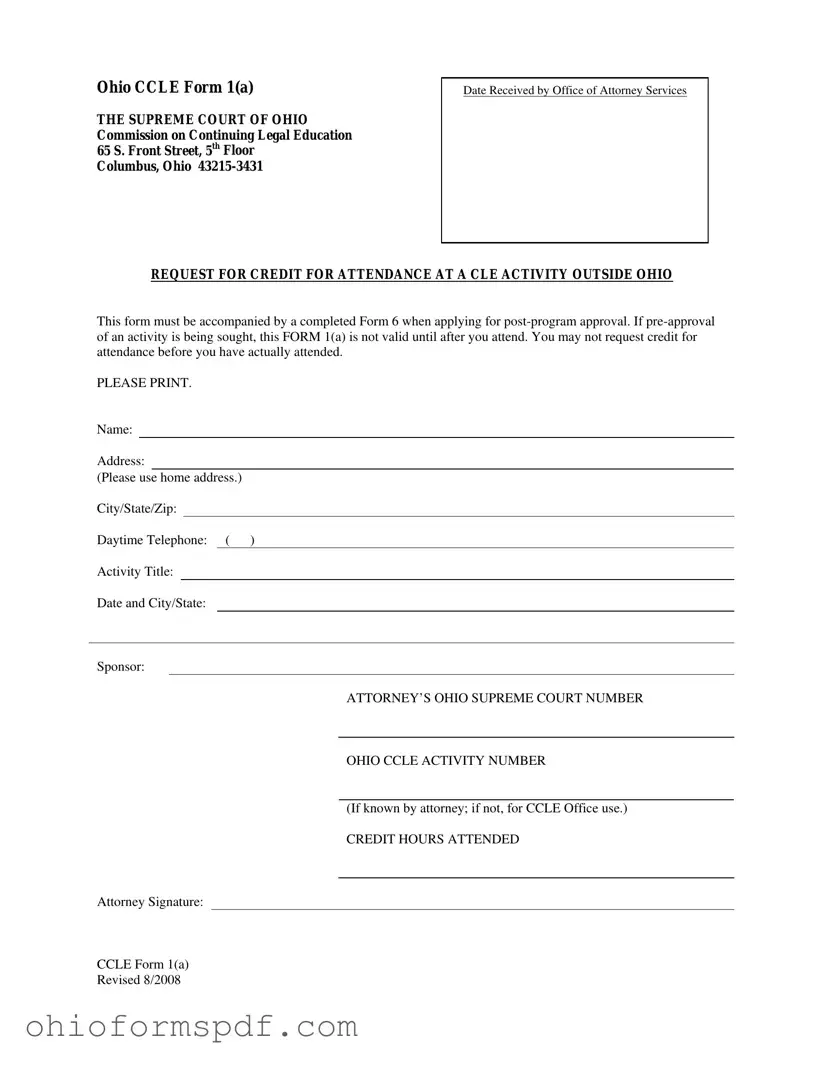The Ohio CCLE Form 1(a) is designed for attorneys to request credit for attending Continuing Legal Education (CLE) activities outside of Ohio. A similar document to this is the Application for CLE Credit Form used in various other states, such as New York or California. These forms are similar because they also require attorneys to provide details about the CLE activity they attended, including the activity title, date, location, and sponsor. Moreover, these forms are used to ensure that the attorney receives the appropriate credit towards their CLE requirements, which are mandated to maintain their law license in good standing.
Another document closely related to the Ohio CCLE Form 1(a) is the Uniform Certificate of Attendance for CLE Programs. This certificate is often given to attendees at the end of a CLE activity. It serves as proof of attendance and includes information similar to what is requested on the Ohio form, such as the event's title, date, and the number of CLE credits earned. Attorneys can submit this certificate along with the relevant CLE credit request form to their state's CLE board or commission, similar to how they would use the Ohio CCLE Form 1(a).
The Attorney Record of Attendance Form is also akin to the Ohio CCLE Form 1(a). This document is commonly used by attorneys to keep track of their CLE attendance over a reporting period. While it is more of a personal log than a formal credit request, it still gathers information comparable to the CCLE Form, such as the course titles, dates attended, and credits earned. This record can be pivotal when submitting formal requests for CLE credit approval, supporting the information provided on forms like the Ohio CCLE Form 1(a).
The Post-Program Evaluation Form, often used by CLE providers, gathers feedback from attendees regarding the quality and relevance of the CLE activity. While its primary function is to collect evaluations, it also records attendee information, activity details, and sometimes the number of CLE credits claimed. This information parallels the details required by the Ohio CCLE Form 1(a). Through this similarity, both documents play a role in the process of earning and validating CLE credits.
The CLE Provider Application Form, which CLE providers submit to get their courses accredited, shares similarities with the Ohio CCLE Form 1(a) in terms of the detailed information about a CLE activity. While one form is used by providers to apply for course accreditation and the other by attorneys to claim credit, both require specific details about the CLE activity, such as its title, date, location, and the number of credit hours. This ensures that the content meets the educational standards set by the state's legal education commission.
An Attorney Application for Teaching CLE Credit closely resembles the Ohio CCLE Form 1(a) in its purpose of claiming CLE credits. However, instead of attending, these credits are for teaching a CLE course. This form requires similar information about the course, such as the title, date, and location, along with additional details about the teaching role and content covered. The focus on educational contribution rather than attendance illustrates a broader approach to earning CLE credits, while still maintaining rigorous documentation standards.
The Online CLE Credit Request Form, increasingly common in today’s digital age, allows attorneys to request CLE credits for webinars and other online educational activities. Like the Ohio CCLE Form 1(a), it requires specifics about the online activity, including its title, date, sponsor, and the number of credit hours attended. The shift towards online platforms for CLE activities necessitates a similar approach to accreditation and credit allocation, underscoring the flexibility and adaptability of continuing legal education across different formats.
The Pro Bono Service Credit Request Form is another document that bears resemblance to the Ohio CCLE Form 1(a), as it is used by attorneys to claim CLE credits for pro bono legal services provided. This form requires information about the service provided, including the dates of service and description of work. While its focus is on legal service rather than education, the process of reporting and validating these experiences for CLE credit parallels the detailed recording and submission process seen with educational activity credits.

